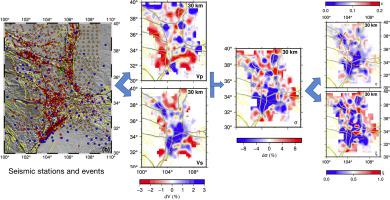当前位置:
X-MOL 学术
›
Phys. Earth Planet. Inter.
›
论文详情
Our official English website, www.x-mol.net, welcomes your
feedback! (Note: you will need to create a separate account there.)
Cracks and fluids in the Northeast Tibetan crust: New insight into seismotectonics
Physics of the Earth and Planetary Interiors ( IF 2.4 ) Pub Date : 2021-02-01 , DOI: 10.1016/j.pepi.2020.106634 Anhui Sun , Dapeng Zhao , Huili Guo
Physics of the Earth and Planetary Interiors ( IF 2.4 ) Pub Date : 2021-02-01 , DOI: 10.1016/j.pepi.2020.106634 Anhui Sun , Dapeng Zhao , Huili Guo

|
Abstract We determine high-resolution 3-D images of seismic velocity (Vp and Vs) and Poisson's ratio (σ) of the crust and uppermost mantle beneath NE Tibet by jointly inverting first and later phase (PmP and SmS) arrival times from 6076 local earthquakes recorded at 872 seismic stations of the China Seismic Network and the portable ChinArray and SACHY projects. We then estimate 3-D images of crack density (e) and saturation rate (ξ) using the obtained Vp, Vs and σ values. Our results reveal significant crustal heterogeneities and anomalous low-σ anomalies in the middle crust beneath the northeastern Bayan Har block, the western Qinling fold zone and the transitional tectonic belt to the east of the Tibetan Plateau. The low-σ features reflect partially saturated cracks due to dilatation or vaporization in the upper to middle crust, rather than lithologic variations alone. Moreover, high-ξ anomalies exhibit a wider distribution than that of high-e anomalies, which may suggest that micro-cracks exist in more localized areas, such as in and around active fault zones, whereas fluids are permeating through wider areas in the crust. The discrepancy between e and ξ in the middle crust may be associated with dehydration of materials from regional crustal flow and asthenospheric flow. Our results provide new information on the fault zone rheology and seismogenesis of the study region, such as the generation of the 1920 Haiyuan earthquake (M 8.5), which might be related to fluid-filled, fractured rock matrices in the crust.
更新日期:2021-02-01











































 京公网安备 11010802027423号
京公网安备 11010802027423号